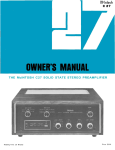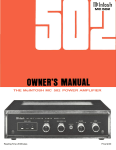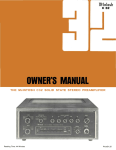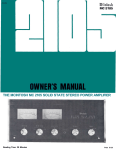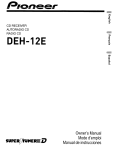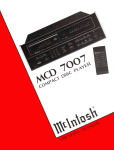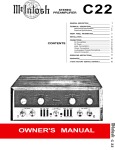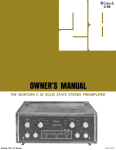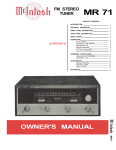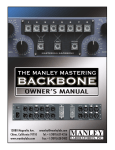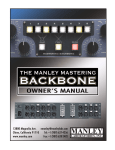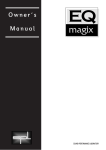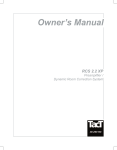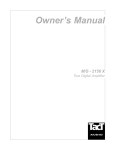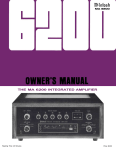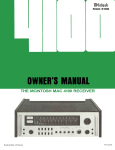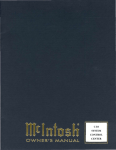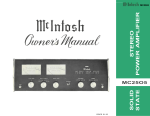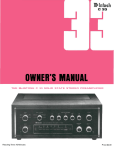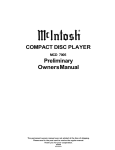Download McIntosh C35 - SERVICE Operating instructions
Transcript
IMPORTANT SAFETY INSTRUCTIONS THESE INSTRUCTIONS ARE TO PROTECT YOU AND THE MclNTOSH INSTRUMENT. BE SURE TO FAMILIARIZE YOURSELF WITH THEM. 1. Read all instructions - Read the safety and operating instructions before operating the instrument. 2. Retain Instructions - Retain the safety and operating instructions for future reference. 3. Heed warnings - Adhere to warnings and operating instructions. 4. Follow Instructions - Follow all operating and use instructions. WARNING: TO REDUCE RISK OF FIRE OR ELECTRICAL SHOCK, DO NOT EXPOSE THIS INSTRUMENT TO RAIN OR MOISTURE. 5. Power Sources - Connect the power supply only to the type described in the operating instructions or as marked on the unit. 6. Power-Cord Protection - Route power-supply cords so that they are not likely to be walked on or pinched by items placed upon or against them, paying particular attention to cords at plugs, convenience receptacles, and the point where they exit from the instrument. 7. Ventilation - Locate the instrument for proper ventilation. For example, the instrument should not be placed on a bed, sofa, rug, or similar surface that may block ventilation openings; or, placed in a built-in installation, such as a bookcase or cabinet, that may impede the flow of air through the ventilation openings. 8. Heat - Locate the instrument away from heat sources such as radiators, heat registers, stoves, or other appliance (including amplifiers) that produce heat. 9. Wall or Cabinet Mounting - Mount the instrument in a wall or cabinet only as described in the owners manual. 10. Water and Moisture - Do not use the instrument near water - for example, near a bathtub, washbowl, kitchen sink, laundry tub, in a wet basement, or near a swimming pool, etc. 11. Cleaning - Clean the instrument by dusting with a dry cloth. Clean the panel with a cloth moistened with a window cleaner. 12. Object and Liquid Entry - Do not permit objects to fall and liquids to spill into the instrument through enclosure openings. 13. Power Lines - Locate any outdoor antenna away from power lines. 14. Outdoor Antenna Grounding - If an outdoor antenna is connected to the antenna terminal, be sure the antenna system is grounded to provide some protection against voltage surges and built up static charge. In the U.S.A., section 810 of the National Electrical Code, ANSI/NFPA No. 70-1987, provides information on the proper ground for the mast and supporting structure, ground for the lead-in wire to an antenna discharge unit, and size of ground conductors, location of antenna-discharge unit, connection to grounding electrodes, and requirements for the grounding electrode. For ground wire: a) Use No. 10 AWG (5.3 mm2) copper No. 8 AWG (8.4 mm2) aluminum, No. 17 AWG (1.0 mm2) copper-clad steel, bronze wire, or larger as ground wire. b) Secure antenna lead-in and ground wires to house with stand-off insulators spaced from 4 feet (1.22 meters) to 6 feet (1.83 meters) apart. c) Mount antenna discharge unit as closely as possible to where lead-in enters house, d) Use jumper wire not smaller than No. 6 AWG (13.3 mm2) copper or equivalent when separate antenna grounding electrode is used. 15. Nonuse Periods - Unplug the power cord from the AC power outlet when left unused for a long period of time. 16. Damage Requiring Service - Service must be performed by qualified service personnel when: A. The power supply cord or the plug has been damaged; or B. Objects have fallen, or liquid has been spilled into the instrument; or C. The instrument has been exposed to rain; or D. The instrument does not appear to operate normally or exhibits a marked change in performance; or E. The instrument has been dropped, or the enclosure damaged. 17. Servicing - Do not attempt to service beyond that described in the operating instructions. All other service should be referred to qualified service personnel. 18. Grounding or Polarization - Do not defeat the inherent design features of the polarized plug. Non-polarized line cord adaptors will defeat the safety provided by the polarized AC plug. The lightning flash with arrowhead, within an equilateral triangle, is intended to alert the user to the presence of uninsulated "dangerous voltage" within the product's enclosure that may be of sufficient magnitude to constitute a risk of electric shock to persons. 19. CAUTION: TO PREVENT ELECTICAL SHOCK DO NOT USE THIS (POLARIZED) PLUG WITH AN EXTENSION CORD, RECEPTACLE OR OTHER OUTLET UNLESS THE BLADES CAN BE FULLY INSERTED TO PREVENT BLADE EXPOSURE. Note to CATV system installer: This reminder is provided to call the CATV system installer's attention to Article 820-22 of the NEC that provides guidelines for proper grounding and, in particular, specifies that the cable ground shall be connected to the grounding system of the building, as close to the point of cable entry as practical. ATTENTION: POUR PREVENIR LES CHOCS ELECTRIQUES PAS UTILISER CETTE FICHE POLARISEE AVEC UN PROLONGATEUR, UNE PRISE DE COURANT OU UNE AUTRE SORTIE DE COURANT, SAUF SI LES LAMES PEUVENT ETRE INSEREES A FOND SANS EN LAISSER AUCUNE PARTIE A DECOUVERT. The serial number, purchase date, and Mclntosh Laboratory Service Contract number are important to you for possible insurance claim or future service. Record this information here. Serial Number Purchase Date CAUTION: TO PREVENT THE RISK OF ELECTRIC SHOCK, DO NOT REMOVE COVER (OR BACK). NO USER-SERVICABLE PARTS INSIDE. REFER SERVICING TO QUALIFIED PERSONNEL. The exclamation point within an equilateral triangle is intended to alert the user to the presence of important operating and maintenance (servicing) instructions in the literature accompanying the appliance. Service Contract Number Upon application, Mclntosh Laboratory provides a Service Contract to the original purchaser. Your Mclntosh Authorized Service Agency can expedite repairs when you provide the Service Contract with the instrument for repair. 1 Contents INTRODUCTION INSTALLATION HOW TO CONNECT FRONT PANEL CONTROLS PERFORMANCE LIMITS PERFORMANCE CHARTS BLOCK DIAGRAM TECHNICAL DESCRIPTION CONNECTING DIAGRAM 3 4, 5 6, 7, 8 9, 10 11 12, 13 14 15 16 Your C35 System Control Center will give you many years of satisfactory performance. If you have any questions, please contact, CUSTOMER SERVICE Mclntosh Laboratory Inc. 2 Chambers Street Binghamton, New York 13903-2699 Phone: 607-723-3512 Take Advantage of 3 Years of Contract Service. . . Fill in the Application NOW. MclNTOSH THREE YEAR SERVICE CONTRACT An application for A THREE YEAR SERVICE CONTRACT is included with this manual. The terms of the contract are: 1. If the instrument covered by this contract becomes defective, Mclntosh will provide all parts, materials, and labor needed to return the measured performance of the instrument to the original performance limits free of any charge. The service contract does not cover any shipping costs to and from the authorized service agency or the factory. 2. Any Mclntosh authorized service agency will repair all Mclntosh instruments at normal service rates. To receive the free service under the terms of the service contract, the service contract certificate must accompany the instrument when taken to the service agency. 3. Always have service done by a Mclntosh authorized service agency. If the instrument is 2 modified or damaged as a result of unauthorized repair the service contract will be cancelled. Damage by improper use or mishandling is not covered by the service contract. 4. The service contract is issued to you as the original purchaser. To protect you from misrepresentation this contract cannot be transferred to a second owner. 5. Units in operation outside the United States and Canada are not covered by the Mclntosh Factory Service Contract, irrespective of the place of purchase. Nor are units acquired outside the USA and Canada, the purchasers of which should consult with their dealer to ascertain what, if any, service contract or warranty may be available locally. Mclntosh has earned world renown for its technological contributions for improved sound. When you bought Mclntosh, you bought not only high technology, you bought technological integrity proven by time. The Mclntosh C 35 System Control Center is the newest evidence of Mclntosh technological integrity. Music reproducing instruments that carry the Mclntosh name have always been designed for technological leadership and to maintain the Mclntosh reputation for best sound, for durability, and for long life. Mclntosh has always earned the foremost reputation for quality performance. Mclntosh has provided user oriented facilities and appearance and Mclntosh design always provides for ease of maintenance or repair. These fundamental elements are incorporated in the Mclntosh System Control Center, yet it is easy to operate. Your Mclntosh C 35 System Control Center, above all others will deliver to you the best sound, the most flexibility, and the greatest ease of use. The C 35 is a superb quality, high performance System Control Center. With the MVS-1 Video Selector, it will provide both audio and video control. The C 35 has many useful features to enhance your listening and video enjoyment. They include: High level inputs to accommodate the traditional as well as all the latest audio sources such as compact disc players and the high-quality audio from video recorders and laser video disc players. A specially designed low noise switching system uses a pair of cascaded field effect transistors (FET) to operate the inputs. The input leads are very short, one-twentieth (1/20) of the length of previous designs. Advantages include, source-to-source isolation, lower distortion, and freedom from hum, noise, and interference from high-power TV and radar signals. Any one of nine input sources can be selected using electronic switching. These inputs identified as Compact Disc, LASER disc, TV, TUNER, PHONO, AUX 1, AUX 2, VCR/T1, and VCR/T2. Electronic tape monitor switches for two audio tape recorders, or the audio from two video recorders, or one audio recorder and the audio from one video recorder, allow either recorder to be heard from the main output. Volume is adjusted by a motor driven precision potentiometer. Left/right tracking accuracy is controlled to a fraction of a dB. SPEAKER buttons select both or either of two sets of loudspeakers (when used with the optional SCR 3 speaker control relay) or two additional power amplifiers, which can provide program to other listening areas. These facilities and more may be selected and controlled by either the buttons on the front panel or the hand-held infrared remote control. Additionally, remote control can be extended to two additional listening areas by the installation of Mclntosh remote sensors which are easily connected by RG-59/U cable. An active circuit loudness control is electrically independent of the volume control. Close conformity to the Fletcher-Munson equal loudness curves can be attained regardless of the volume setting. A five-band program equalizer permits the adjustment and improvement of the loudness contrast of the five most important frequency ranges. Musical balance of source material can be adjusted to compensate for room recording differences or listener preferences. Rear panel signal switching jacks provide output and input facilities for signal processing equipment. Processors may be used independently to modify a tape recording or the listened-to program. A built-in headphone amplifier provides power to the front panel headphone jack. All front panel controls are available to influence private listening on headphones. Electronically regulated power supplies maintain stable operation during periods of changing line voltage. Professional XLR connectors provide balanced optimum signal to noise ratio in demanding applications. This outstanding C 35 System Control Center will serve you best when you understand its functions and what it is designed to do. Some time invested in reading this manual will be valuable in obtaining the most from your C 35. INTRODUCTION 3 The trouble-free life of an electronic instrument is greatly extended by providing sufficient ventilation to prevent the build-up of high internal temperatures that cause deterioration. Allow enough clearance so that cool air can enter at the bottom of the cabinet and be vented from the top. With adequate ventilation the instrument can be mounted in any position. The recommended minimum space for installation is 15 inches (38.1 cm) deep, 17 inches (43.2 cm) wide, and 6 inches (15.2 cm) high. The C 35 may be installed in a Mclntosh cabinet or custom installed in furniture of your choice. Always provide adequate ventilation, Never place it above heat generating components such as high powered amplifiers. Provide 1½ inches (3 cm) of space above the preamplifier so as not to interfere with a cooling air flow. CUSTOM INSTALLATION The PANLOC system of installing equipment conveniently and securely is a product of Mclntosh research. The PANLOC buttons on the front pane! will lock the unit firmly in place when they are turned approximately one quarter turn clockwise. A counterclockwise turn of the PANLOC buttons unlocks the chassis from its mounting. To install the instrument in a Mclntosh cabinet, follow the instructions that are enclosed with the cabinet. For any other type of installation, follow these instructions: the instrument from its plastic bag and place it upside down on the shipping pallet. Unscrew the four plastic feet from the bottom of the chassis. 2. Mark the Cabinet Panel Tape the mounting template in position on the cabinet panel where the instrument is to be installed. The broken lines that represent the outline of the rectangular cutout also represent the outside dimensions of the chassis. Make sure these lines clear shelves, partitions, or any equipment. With the template in place, first mark the six A and B holes and the four small holes that locate the corners of the cutout. Then, join the four corner markings with pencil lines, using the edge of the template as a straightedge. 3. Drill Holes Use a drill with a 3/16 inch (5 mm) bit held perpendicular to the panel and drill the six A and B holes. Then, using a drill bit slightly larger than the tip of your saw blade, drill one hole at each of two diagonally opposite corners. The holes should barely touch the inside edge of the penciled outline. Before taking the next step, make sure that the six A and B holes have been drilled. 1. Unpack from Carton Open the carton and remove the PANLOC brackets, hardware package, and mounting template. Remove 4 INSTALLATION 4. Saw the Panel Cutout Saw carefully on the inside of the penciled lines, First make the two long cuts and then the two short cuts. After the rectangular opening has been cut out, use a file to square the corners and smooth any irregularities in the cut edges. 5. Install the Mounting Strips In the hardware package are two mounting strips, and two 1-1/4" (31.8mm) black long screws that have a flat head. Use these screws, one on each end, to fasten the mounting strips. They are attached through the center hole, marked B on the template. Make sure the screw heads are drawn flush or slightly into the wood before attaching the Panloc brackets. 6. Attach the PANLOC Brackets In the hardware package are two sets of screws. For panels less than 1/2" (12.7mm) thick, use the 3/4" (19.1mm) long screws; for thicker panels, use the 1-1/4" (31.8mm) long screws. Using two screws of the proper length in the A holes on each side, attach the PANLOC brackets to the cabinet panel; the short flange is mounted against the front (face) of the cabinet panel. The screws pass through the PANLOC bracket flange, the cabinet panel, and then through the mounting strips previously mounted. 7. Install the Instrument Guide the AC power cord through the panel opening to the back of the cabinet; then, slide the instrument into the opening carefully so that the rails on the bottom of each side of the chassis engage the tracks on the mounting brackets. Continue to slide the instrument into the cabinet until the front panel is flush with the cabinet panel. Turn the PANLOC buttons at the lower left and right corners of the instrument panel clockwise to lock the unit firmly in the cabinet. Turn the PANLOC buttons counterclockwise to unlock the instrument. It can then slide outward to permit the removal. INSTALLATION 5 be connected to the TV INPUT. Connect the left channel cable to the Left TV INPUT. Connect the right channel cable to Right TV INPUT. The output of a monophonic TV set can be connected to both left and right channel TV INPUTS by use of a "Y" connector. The back cover of this manual folds out to show photographs of the front and rear panels of the C 35. Fold it out to assist you in locating the connectors. The numbers refer to the paragraphs that follow. There are four fields of audio connectors on the back panel of the C 35 for use with associated equipment: AUDIO INPUTS, EXTERNAL PROCESSORS, AUDIO OUTPUTS, and BALANCED OUTPUTS. On the front panel is an additional phone jack for use with headphones. Use shielded cables to interconnect the source equipment and the preamplifier. To minimize the possibility of hum or noise, the shielded cables should be of parallel construction or, if not, loosely twist the left and right cables together. Locate them away from the speaker connecting cables and AC power cords. Be certain to use good quality shielded cables for all interconnections. Your dealer can advise you on the kind and length of cable that will best suit your installation. The first field of connectors is marked: AUDIO INPUTS 1. PHONO: Connect the cable from the turntable left channel to the Left Phono INPUT. Connect the cable from the turntable right channel to the Right PHono INPUT. If the turntable has a separate ground lead, connect it to the screw terminal marked ground (GND). 2. GND (ground): The ground (GND) post on the rear panel is provided primarily for grounding a turntable or record changer that has a separate ground lead in addition to the signal leads. 3. CD: Connect the cable from the Compact Disc (CD) player left channel output to the Left CD INPUT. Connect the cable from the CD player right channel output to the Right CD INPUT. 4. LASER VISION PLAYER: The audio from a laser vision video disc player can be connected to the LASER INPUT. Connect the cable from the left channel audio output of a laser disc player to the Left LASER INPUT. Connect the cable from the right channel audio output of a laser disc player to the Right LASER INPUT. 5. TV: Audio from a stereo TV set or TV monitor can 6. TUNER: Connect the cable from the tuner left channel output to the Left TUNER INPUT. Connect the cable from the tuner right channel output to the Right TUNER INPUT. 7. AUX 1 AND 2: Audio from any high level source is connected to AUX 1 or 2 INPUTS. Connect a cable from the left channel audio output of a TV monitor or other high level source, to the Left AUX 1 INPUT jack. Connect a cable from the right channel audio output to the Right AUX 1 INPUT jack. AUX 2 may be used in a similar manner. 8. VCR 1/TAPE 1: For tape playback or to monitor while recording: connect a cable from the tape recorder left channel output to the Left VCR 1/TAPE 1 INPUT. Connect a cable from the tape recorder right channel output to the Right VCR 1/TAPE 1 INPUT. Connect a second recorder in the same manner to the VCR 2/TAPE 2 INPUT. Video Tape Recorders: If you prefer, one or both of the VCR/TAPE INPUTS can be used for the audio from a VCR. Connect the left channel audio output from the VCR to the Left VCR 1/TAPE 1 INPUT. Connect the right channel audio output from the VCR to the Right VCR 1/TAPE 1 INPUT. If the VCR has only a single audio output (mono), use a "Y" connector to connect the program to both the left and right input. The second field of connectors is marked: EXTERNAL PROCESSORS 9. EXTERNAL PROCESSORS There are two sets of EXTERNAL PROCESSOR jacks. The TAPE set affects the program fed to the VCR/TAPE 1 and 2 OUTPUT jacks and the MAIN set affects the program fed to the AUDIO OUTPUTS MAIN and SWITCHED 1 and 2 jacks. Use the EXTERNAL PROCESSOR jacks to add a noise reduction or any audio signal processing device. Be sure to match the left to left and right to right channels when connecting external processors. The EXTERNAL PROCESSOR-FROM jacks have 6 HOW TO CONNECT shielded cables with XLR type connectors to connect between the preamplifier and the power amplifier. When using 2 conductor shielded cables with XLR type connectors, connect the BALANCED OUTPUT LEFT of the preamplifier into the left XLR connector on the power amplifier. Connect the BALANCED OUTPUT RIGHT on the preamplifier to power amplifier right XLR connector. Pin configuration of the XLR connectors is: PIN 1: Shield ground PIN 2: + OUT PIN 3: - OUT. switching contacts which allow the signal to pass through them when nothing is plugged into the jacks. When an external processor is used, the program is routed to the external processor from the EXTERNAL PROCESSOR TO jack and back by the EXTERNAL PROCESSOR FROM jack. WHEN AN EXTERNAL PROCESSOR IS USED, IT MUST BE TURNED ON FOR THE PROGRAM TO BE HEARD THROUGH THE SYSTEM. The third and fourth fields of connectors are marked: AUDIO OUTPUTS and BALANCED OUTPUTS 10. VCR 1/TAPE 1 and VCR 2/TAPE 2 To record VCR audio or audio tape, connect a cable from the Left VCR 1/TAPE 1 OUTPUT to the left high-level input of the recorder. Connect a cable from the Right VCR I/TAPE 1 OUTPUT to the right input of the recorder. Connect a second recorder in the same manner to the VCR 2/TAPE 2 OUTPUT. 11. MAIN: Connect a cable from the left C 35 MAIN OUTPUT jack to the left power amplifier input jack. Connect a cable from the right MAIN OUTPUT jack to the right power amplifier input jack. 12. SWITCHED 1 and 2: Two additional stereo power amplifiers may be connected to the AUDIO OUTPUT SWITCHED 1 and 2 jacks. Audio output signal is supplied to these jacks only when the front panel button SPEAKER 1 and/or 2 buttons are pressed. This arrangement is useful for systems where separate amplifiers and loudspeakers are used at remote locations. Additional amplifiers can serve remote areas such as selected living areas, workshop, or outdoor recreational facilities. Other devices can be controlled such as a rear channel reverberation unit. 13. BALANCED OUTPUTS Modern technology has made it possible to build preamplifiers and power amplifiers with the high signal-to-noise ratio necessary to reproduce the sound quality present on compact discs. Interconnecting cables can pick up electrical interference from other equipment or applicances. The balanced outputs on the C 35 provide a minimum of 40 dB more protection against such "common mode" noise pick-up. Use 2 conductor 14. AC POWER: Plug the preamplifier AC power cord into a 120 volt 60 Hz wall outlet. The plug blades are polarized so be certain the plug is fully inserted in the outlet to prevent blade exposure. CAUTION: TO PREVENT ELECTRIC SHOCK, DO NOT USE THE (POLARIZED) PLUG ON THIS UNIT WITH AN EXTENSION CORD, RECEPTACLE, OR OTHER OUTLET UNLESS THE BLADES CAN BE FULLY INSERTED TO PREVENT BLADE EXPOSURE. Two types of AC power outlets are provided on the back panel of the C 35. One is red, the rest are black. The red outlet is on at all times and is used with accessories that have their own power switches. For example, a VCR plugged into this outlet will be able to record TV programs when the main audio system is turned off. The black outlets are switched on or off when the C 35 is turned on or off. Use these to provide AC power to amplifiers, CD players, or other accessories. The power capacity of all the outlets, totalled, is 1500 watts. For power consumption above 1500 watts, it is necessary to add a Mclntosh SCR 3 (SPEAKER CONTROL RELAY). The SCR 3 has two AC power outlets that provide additional capacity of 1800 watts switched on or off by the C 35. Use these outlets to supply AC power to amplifiers or other components whenever the total load to be switched exceeds the C 35 rating of 1500 watts. 15. SCR (optional accessory): The SPEAKER CONTROL RELAY (SCR 3) is designed to provide both AC outlet switching and speaker switching. The SCR 3 has two AC power outlets that HOW TO CONNECT 7 provide additional capacity of 1800 watts which is controlled by the AC power switch on the C 35. Use these outlets to supply AC power to amplifiers or other components when the total load switched exceeds the C 35 rating of 1500 watts. Plug the computer-type connector on the cable attached to the SCR 3 into the SCR socket on the rear of the C 35. Plug the SCR 3 heavy, AC power line cord directly into a wall outlet. Do not plug it into the C 35. When the C 35 is turned on, a control voltage from the C 35 will energize a relay in the SCR 3 which connects the two SCR 3 AC power outlets directly to the wall outlet. Two loudspeakers can be turned on or off with the SCR 3 by using the C 35 front panel buttons SPEAKER 1 and 2. Use the SPEAKER 1 terminal strip on the SCR 3 to connect the main listening pair of speakers and SPEAKER 2 terminal strip to a remote area pair of speakers. Connect the power amplifier output to the POWER AMPLIFIER terminal strip. Maintain left and right orientation and like polarity. The SPEAKER 1 button will turn the main speakers on or off and the SPEAKER 2 button will turn the remote speakers on or off. 16. TUNER: A multipin computer-type connector is provided to interconnect the C 35 with Mclntosh tuners designed for infrared remote control. When so connected, the HR 35 remote control will operate the normal functions of the tuner. With this system you can turn on the tuner, select from the preprogrammed stations, search sequentially the programmed stations, or scan the entire broadcast band on either the AM or FM band; and raise or lower volume. 17. VIDEO SELECTOR: (optional accessory) The Mclntosh VIDEO SELECTOR, MVS-1, is designed to enable the C 35 to control video programs as well as audio. The MVS-1 connects to the VIDEO SELECTOR computer-type connector on the rear of the C 35. Follow the instructions with the MVS-1 for connecting the video cables. interference with the main area controlled by the C 35. Additional independent REMOTE CONTROL modules and power amplifier, can be added for each area in which remote control is desired. 19. CD: A DIN connector is provided to interconnect the C 35 with a Mclntosh Compact Disc player. When so connected, the HR 35 remote control for the C 35 will operate these functions of the Compact Disc player: 1) turn the player on or off 2} play a disc 3) move to the next track 4) back up a track 5) raise or lower the volume 6) mute the program. 7) stop the playing of the disc. 20. SENSORS 1 and 2: (optional accessory) Connectors are provided to add two additional Mclntosh infrared sensors. This added convenience permits complete control of the stereo system from areas remote to the location of the C 35. Remote sensors are interconnected with RC-59/U antenna cable. INSERTING THE BATTERIES IN THE HR 35 REMOTE CONTROL Your Mclntosh C 35 System Control Center is complete including Remote Control. In your hand, you have the ability to control all functions of the preamplifier with the exception of these controls: LOUDNESS, BALANCE, VCR/COPY, MONO mode selection and EQUALIZER. These can only be changed by use of the front panel controls. The remote control runs on two AA, 1.5 volt batteries. Slide open the cover on the back of the remote control and insert the batteries as shown in the diagram in the battery compartment, then slide the cover closed again. Battery life is normally about one year. Remove the batteries as soon as they are dead to prevent damage by possible battery leakage or in case the remote control is not to be used for a length of time. 18. AREA CONTROLLER: (optional accessory) Adding the optional Mclntosh R624 Remote Control Interface and the proper Mclntosh REMOTE CONTROL modules provides independent remote control facilities in additional areas. In these areas, source can be selected and the volume adjusted independently of and without 8 HOW TO CONNECT The back cover of this manual folds out to show photographs of the front and rear panels of the C 35. Fold it out to assist you in identifying and locating the controls on the photographs. The letters refer to the paragraphs that follow. The glass upper half of the C 35 front panel is the message center. It illustrates the source, volume setting, mode of operation, tape facilities in use, and connected operating speakers. The infrared sensor which accepts information from the HR 35 hand-held remote control is left of the VOLUME indicator. The black anodized aluminum lower half of the front panel contains the buttons for: 1) source selection 2) mute 3) audio and video tape selection (video capability with accessory Mclntosh MVS-1 Video Switcher) 4) stereo or mono mode selection 5) two area speaker switching (with the accessory SCR 3), and 6} on/off AC power. The five EQUALIZER FREQUENCY controls, BALANCE, and LOUDNESS controls have been retained as rotating knobs to provide a high degree of repeatability. A headphone jack, the VOLUME up and down buttons, and PANLOC locking buttons complete the front panel controls. A. POWER: The red button on the C 35 and the POWER button on the remote control turn the AC power on or off. When turned on, the message center will display (illuminate) the source that has been selected, any special operating modes, and the VOLUME setting. B. SOURCE: To listen to a desired source (CD, LASER, TV, TUNER, PHONO, AUX1 or AUX2, etc), touch either the front panel button or the corresponding HR 35 remote control button. The indicator in the message center for that button will light. C. MUTE: Should you desire to silence the system briefly, touch the MUTE button on either the C 35 or the remote control. A red LED above the MUTE button will light, and the program will be silenced at the MAIN and SPEAKER 1 and 2 AUDIO OUTPUTS only. Touch either button to un-mute. Mute does not affect the tape outputs. D. MONITOR: IMPORTANT: When the C 35 is operated in MONITOR mode with VCR/T1 or VCR/T2 lighted in the message center, the program heard will be that from the tape recorders only. Any other source will not be heard from the loudspeakers. The C 35 is designed to be used with two tape recorders, either audio or video, or one audio and one video recorder. The MONITOR switches are electronically interlocked to prevent simultaneous monitoring from two tape recorders. The four buttons, MONITOR VCR/T1, VCR/T2, VCR/T COPY, 1 2,2 1, control the signal in and out of these recorders. They permit recordings to be monitored while recording, or copying of tapes and listening to a separate program, or the playback of either recorder. MONITOR VCR/T1 button: When VCR/T1 is lighted in the message center, signal from a tape recorder plugged into INPUT VCR/TAPE 1 is fed to the power amplifiers and heard through the loudspeakers. MONITOR VCR/T2 button: Functions similarly to MONITOR VCR/T1. E. VCR/T COPY: 1 2 button: connects the output from tape recorder 1 to the input of tape recorder 2 and lights 1 2 in the message center without affecting the program being heard from the speakers. In this position, a copy of the program on tape recorder 1 can be made on tape recorder 2. To monitor the original, use MONITOR VCR/T1 button and to monitor the copy, use MONITOR VCR/T2 button. 2 1 button: connects the output from tape recorder 2 to the input of tape recorder 1 and lights 2 1 in the message center without affecting the program being heard from the speakers. In this position, a copy of the tape program on recorder 2 can be made on recorder 1. To monitor the original, use MONITOR VCR/T2 button and to monitor the copy, use MONITOR VCR/T1 button. F. MONO: The MONO button adds the left and right program together to provide a monophonic program at the MAIN and SPEAKER 1 and 2 AUDIO OUTPUTS only, and the MONO indicator in the message center will light. MONO does not affect the TAPE OUTPUTS. FRONT PANEL CONTROLS 9 G. SPEAKER 1 and 2 The SPEAKER 1 and 2 buttons can be used to switch on or off either the SWITCHED 1 and 2 AUDIO OUTPUTS jacks or the main and remote speakers when an optional SPEAKER CONTROL RELAY (SCR 3} is used. The SWITCHED 1 and 2 jacks on the rear panel of the C 35 have the same program as the MAIN OUTPUT. When one or both SPKR1 and SPKR2 indicators are lighted in the message center, the program is connected to the corresponding AUDIO OUTPUTS jacks. Program to other devices can be controlled such as rear channel delay, reverberation, etc. Example: connect the SWITCHED 1 jack to the input of a reverberation device, an amplifier and a set of rear loudspeakers. Rear channel reverberation can then be switched on or off by the SPEAKER 1 button. H. HEADPHONES: The HEADPHONES jack has been designed to feed low impedance dynamic headphones. An amplifier in the C 35 provides the necessary power for the HEADPHONES jack. I. EQUALIZER FREQUENCY: Each of five EQUALIZER FREQUENCY controls raises or lowers the amplitude of a band of frequencies centered on the frequency marked above the control. Both left and right channels are affected. The center, or flat position, of the control has a detent for easy reference. In the center or detent position, the entire circuit for that control is removed from the program circuit by grounding the control electronically. The result is a preamplifier that is a "straight wire with gain" or one that has the ability to satisfy the musical balance to your taste. Use the EQUALIZER FREQUENCY controls to modify the sound and balance of program material. Adjustment to Equalizer Correction Make deep bass louder Raise 30 Make all bass louder Raise 30 and 150 Reinforce voices Lower 150 and raise 500 Hum on program Reduce 30 and 150 Brighten violins and trumpets Raise 1500 Emphasize cymbals Raise 10 K J. BALANCE The BALANCE and LOUDNESS controls are concentric. The BALANCE control (large outer knob) adjusts the volume of the channels relative to each other. L-left...turning the control to the left accents the left channel by reducing the right channel output. R-right...turning the control to the right accents the right channel by reducing the left channel output. K. LOUDNESS: The LOUDNESS control (small center knob) provides frequency response contoured to compensate for the behavior of the human ear at lower listening levels. This contour is accurately modeled after the family of "equal loudness" curves identified by Fletcher and Munson. At the fully counterclockwise detented FLAT position, the loudness contour is electrically flat. As the control is turned clockwise, both bass and treble frequencies increase in the correct proportion. The contour is not affected by changes of VOLUME. After adjusting VOLUME for the desired listening level, adjust the LOUDNESS control for the preferred compensation. L. VOLUME: Volume may be adjusted by using the VOLUME or VOLUME on the front panel or the remote control. Control of the volume is performed by a precision attenuator. Left and right tracking is maintained to a fraction of a dB. M. % VOLUME: The VOLUME indicator in the message center is a 2 digit LED display whose numbers represent the percentage of volume and provides 100 point resolution for accurate and repeatable volume control settings. When the AC power is turned on, the last volume setting will be displayed. N. PANLOC: Mclntosh developed PANLOC mounting brings professional installation technique to home stereo systems. When the front panel PANLOC buttons are turned approximately one quarter turn clockwise, the unit is locked into the cabinet. Turning the PANLOC buttons counterclockwise unlocks the C 35, allowing it to be removed. 10 FRONT PANEL CONTROLS PERFORMANCE LIMITS Performance limits are the maximum deviation from perfection permitted for a Mclntosh instrument. We promise you that when you purchase a new C 35 from a Mclntosh franchised dealer, it will be capable of or can be made capable of performance at or exceeding these limits or you can return the unit and get your money back. Mclntosh is the only manufacturer that makes this statement. FREQUENCY RESPONSE + 0, -0.5dB from 20 Hz to 20,000 Hz RATED OUTPUT GENERAL INFORMATION SEMICONDUCTOR COMPLEMENT 49 Bipolar Transistors 73 Field Effect Transistors 35 Integrated Circuits 112 Diodes AC POWER OUTLETS 4 Black, switched, and 1 red, unswitched, 1500 watts total capacity POWER REQUIREMENTS 120 Volts, 50/60Hz, 25 watts 2.5V MECHANICAL INFORMATION OUTPUT IMPEDANCE Balanced 6000 Unbalanced 600 MAXIMUM VOLTAGE OUTPUT Main and Tape Output- 8V from 20 to 20,000 Hz TOTAL HARMONIC DISTORTION 0.002% maximum from 20 to 20,000 Hz at rated output. SENSITIVITY Phono- 2.5mV for 2.5V rated output (0.5mV IHF) High Level- 250mV for 2.5V rated output (50mV IHF) SIGNAL TO NOISE RATIO, A-WEIGHTED Phono- 90dB below 10mV input (84dB IHF) High Level- 105dB below rated output (95dB IHF} MAXIMUM INPUT SIGNAL Phono- 90mV High Level- 10V SIZE: Front panel measures 16 1/8 inches wide (41 cm) by 5 7/16 inches high (13,8 cm) by 13 inches deep (33 cm), including connectors. Knob clearance required is 1 3/8 inches (3.5 cm) in front of mounting panel. FINISH: Front panel is glass with gold/teal nomenclature illumination and anodized gold and black aluminum. Chassis is black. MOUNTING: Exclusive Mclntosh developed professional PANLOC. WEIGHT: 18 pounds (8.2 kg) net, 30 pounds (13.6 kg) in shipping carton. INPUT IMPEDANCE Phono- 47K ohms and 65pF capacitance High Level- 22k ohms VOLTAGE GAIN Phono to Tape- 40dB Phono to Main- 60dB High Level to Tape- 0dB High Level to Main- 20dB EQUALIZATION CONTROLS Variable 12dB boost to 12dB cut at center frequencies of 30, 150, 500, 1500, 10kHz PERFORMANCE LIMITS 11 EQUALIZE R FREQUENCY RESPONSE CONTROLS SET AT M AXlMUM AND MINIMUM 20 RESPONSE IN dB 10 0 -10 20 100 1K FREQUENCY IN HERTZ 10K 20K FREQUENCY RESPONSE HIGH LEVEL IN TO MAIN OUT LOUDNES S CONTROL RESPONSE FOR VARI OUS CONTROL POSITIONS 20 15 RESPONSE IN dB RESPONSE IN dB 0 10 5 -1 -2 -3 -4 -5 -6 -7 0 20 100 1K FREQUENCY IN HERTZ 10K 20K 100 1K FREQUENCY IN HERTZ 12 PERFORMANCE CHARTS 10K 20K RESPONSE IN dB RIAA EQUALIZATION CURVE 10 0 -10 -20 1K 100 20 10k 20K FREQUENCY IN HERTZ HARMONIC DISTORTION AUX IN TO MAIN OUT HARMONIC DISTORTION IN PRECENT 0.05 0.04 0.03 0.02 0.01 0 0 I 2 3 4 5 6 7 8 9 10 RMS OUTPUT VOLTS PERFORMANCE CHARTS 13 14 BLOCK DIAGRAM FULL ELECTRONIC SWITCHING All signal switching including input tape, tape-totape, and mono is done elctronically using J-FET field effect analog switches. All the front panel switches control small amounts of DC voltage which turn the FET analog switches on and off. The critical audio signals are switched silently with instantaneous muting between switch positions. No transient switching noises or pops are present with this superior design. PHONO AMPLIFIER The phono amplifier uses a high technology integrated circuit operational amplifier. Its differential input stage has been optimized for low noise and low distortion performance. Open loop gain of this integrated circuit is 100,000. With high open loop gain, a large amount of negative feedback can be used around the phono amplifier to further reduce noise and distortion. The feedback network also provides precision RIAA frequency compensation. The network uses 1% metal film resistors and 5% polypropylene film capacitors. To achieve low-noise performance it is essential that the feedback network have very low impedance. As a consequence, the preamplifier must be capable of operating as a power amplifier to drive this impedance. The actual power output capability of this preamplifier stage is more than 100 milliwatts, a great margin beyond that which is required. Input sensitivity of the phono amplifier is 2.5 millivolts. The gain of the amplifier is 40dB at 1000Hz. The phono amplifier has a very wide dynamic range. At 1000Hz, the phono input circuit will accept 90 millivolts without overload, a voltage far greater than the output of any current magnetic phono cartridge. Phono input overload, therefore, is virtually impossible. A signal level of 10 millivolts at the phono input at 1000Hz will produce 1 volt at the tape output. The tape output has a source impedance of 200 ohms, designed to operate into a load impedance of 10,000 ohms or greater. LOUDNESS AMPLIFIER many variables such as volume control position and differences in input level. The C 35 uses active loudness control circuitry. The same type of integrated circuit operational amplifier that is used in the phono amplifier is used here. It has two feedback loops. One feedback loop has flat response. The other feedback loop conforms to the FletcherMunson equal loudness compensation. A potentiometer is placed between these two feedback loops making it possible to select any combination of the two from a flat response to full loudness compensation. The overall gain of the loudness stages is 20dB and is not affected at mid frequencies by the position of the loudness control. EQUALIZER AMPLIFIER The equalizer amplifier uses high technology integrated circuit operational amplifiers. Its output stage has been optimized for the best transient performance and minimum distortion. Four other operational amplifiers are each arranged in a circuit configuration that is the equivalent of series tuned circuits, one at each of the five center frequencies. Each series tuned circuit is inserted via a control potentiometer into either the input circuit or feedback circuit of the operational amplifier, thereby, providing a boost and cut capability of 12dB for each band of frequencies. The overall gain of the stage is 0dB. CONTROL LOGIC All inputs, outputs, CD, Tuner, SCR, and Video Selector lines are controlled by logic circuits in the C 35. The logic can be changed by front panel switches or by the infrared remote control system receiver in the C 35. The infrared receiver's information comes from the remote transmitter HR 35. Input selection, volume level, speaker selection, power on/off can be made at the C 35 front panel. Mclntosh tuners and CDs are controlled from the remote transmitter. A back-up power supply keeps all selections memorized when the C 35 power switch is turned off as long as 120 volts AC power to the C 35 is not interrupted. At the input to the high level or loudness amplifier, the signal passes through the electronic mono switch, then through the volume control, and into the loudness amplifier. In the past, loudness controls have typically used simple passive circuits connected to a tap on the volume control. As a consequence, compensation accuracy was dependent on TECHNICAL DESCRIPTION 15 C 35 TYPICAL SIMPLIFIED CONNECTIONS TIME DELAY POWER AMPLIFIER AUDIO TAPE 2 VCR TIME DELAY OR REAR SPEAKERS AUDIO TV TAPE 1 AUDIO VCR SECOND AREA SPEAKERS MAIN SPEAKERS LASER VISION PLAYER OTHER HIGH LEVEL SOURCE OTHER HIGH LEVEL SOURCE SECOND AREA POWER AMPLIFIER MAIN POWER AMPLIFIER BALANCED MAIN OUTPUT TO MAIN POWER AMPLIFIER SIGNAL PROCESSOR TO MAIN OUTPUT SIGNAL PROCESSOR TO TAPE OUTPUT CD TURNTABLE TUNER CONTROL CABLE FOR MVS-1 VIDEO SELECTOR (OPTIONAL) CONTROL CABLE FOR IR CONTROLLED COMPACT DISC PLAYER CABLE TO R624 MULTIPLE AREA REMOTE CONTROLLER (OPTIONAL] CONTROL CABLE FOR SCR 3 A/C AND SPEAKER SWITCH (OPTIONAL) CONTROL CABLE FOR IR REMOTE CONTROL TUNER CONTROL CABLE 16 CONNECTING DIAGRAM EXTERNAL SENSORS (OPTIONAL) THE LOCATION OF CONTROLS The numbers and letters correspond to the paragraphs on pages 6, 7, 8, 9 and 10




















